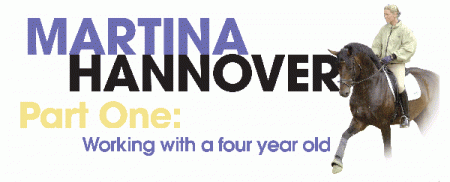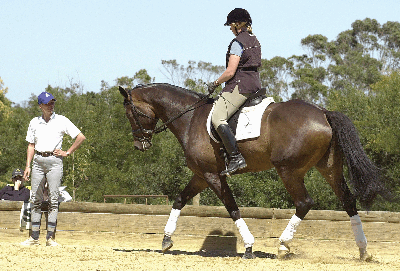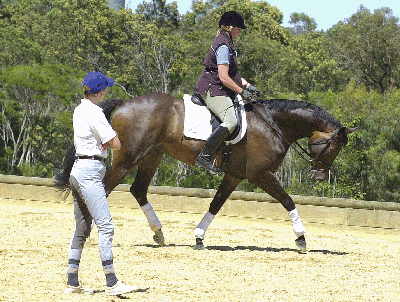Jim and Emmie Schmul’s new property is the perfect setting for an exhilarating clinic with Martina Hannöver. Martina is on her second visit to Australia, and has found that her relaxed, breezy lots of fun style goes down well with the locals. However, unlike some of our visitors she does not lower her standards to make friends. She may be smiling one minute, but do the wrong thing and expect some serious volume!
“Prepare for canter.”
Her first rider of the morning is Bettina Winch on a lovely four and a half year old gelding by Carbine, Cruise. He is out of a Thoroughbred mare, and it has been a good cross, producing a big elegant stretchy youngster.
Still that welcoming smile doesn’t last much longer than the time it takes to circle the arena – once!
“Forward, forward, forward. If he gets tense on your leg, don’t let him go backwards -go forward. He has a very good exterior, he just needs to go in a really normal way. A little bit longer in his neck, and looser through his body.”
“And STAY AWAY FROM THE WALL!”
“What young horses like to do is make us balance them, especially on the left rein – they must balance themselves. Keep your hands together, don’t help him balance. You have to teach this young horse that this is his trot – nothing more. Just into your soft hands, steady and comfortable in this rhythm. Don’t pull on the inside rein, keep your hands together. Don’t press with your legs, try to make your legs long and quiet.”
And the minute Bettina sits, Cruise canters…
“NO! He must let you sit a few steps, not like the jumping horses that the minute the rider goes to sitting trot, they canter. Sit a few strides, then go rising trot again, he must unlearn that sitting trot means canter. You must take the tension out of him. It is not good when the horse is a few seconds in front of us, not good when he is a few seconds behind us either.”
“The horse must be able to carry us in an open relaxed way. If he gets tense, you can’t sit. This horse has very nice rhythm.”In almost all her lessons, Martina stressed the use of the outside rein to turn the horse, and over and over again, she had to remind all the riders to get off their inside rein. It does seem to be an Australian habit.
And just when Bettina is starting to enjoy that rhythm, the youngster gets a bit tangled up going into the short side, and she starts to rebalance him. Martina says no: “I know the feeling with young horses. The wall is coming up and he is not balanced, but still the horse must go forward.”
“Use the whip, but don’t pull back when you use it.”
And the baby has a little hump at the whip…
“Forward. When you come with the whip something must happen – always forward with the whip.”
And when Bettina is brave and does just that ‘good pat him’.
Just briefly at the end, Martina has the rider shorten the horse in a canter circle: “Now we can see how he will be next year. Don’t pull back, don’t let him come back, still forward, but more up into the rein. This is so hard for young horses – that is enough for today.”
So what was Martina aiming to achieve in that lesson?
“For this horse, because on the mother side he is from a Thoroughbred, he needs to be not so tense in his body. To open up a little bit more – especially in front of the saddle, in the neck to go a little bit deeper. We saw towards the end of the lesson, when he opened up a bit more and went down with his neck, but still round, that the movement got bigger in the front legs. He was good behind from the beginning, but the front legs got bigger and bigger.”
Exercises?
“Just what we did here. Straight and circles, Having him straight in front of the inside leg, transitions from circle to straight, work on the bending and getting him straight on the long side. Transitions a little bit in trot and canter, but actually this horse needs to go a little more forward. That is always the most important thing, that the horse is in front of the aids.”
Is that the worst thing Australian riders do – that they don’t have the horse truly forward to their aids?
“I think so. The horses I have had in the clinics here, and even what I saw at Equitana. Nadine (Capelmann) was saying all the time, you must have your horse more in front of your aids, in front of your inside leg – that’s what we Germans probably do more.”
Next month, Martina works with an older more experienced horse – with a quite different set of challenges…





